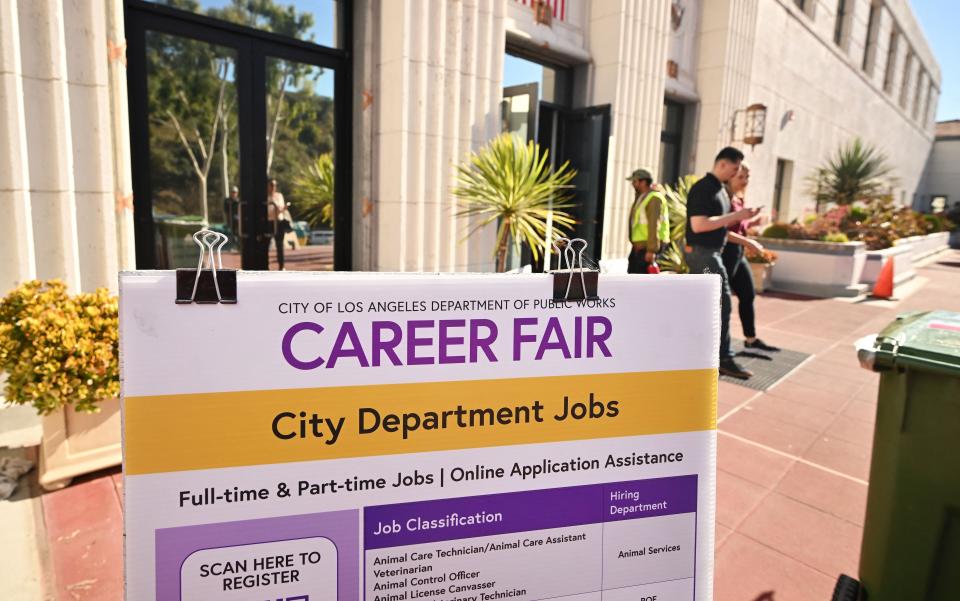November jobs report shows economy added 199,000 jobs; unemployment at 3.7%
Hiring picked up in November as striking auto workers and actors returned to the fold, and businesses continued to largely shrug off high inflation and interest rates.
Employers added 199,000 jobs and the unemployment rate fell from 3.9% to 3.7%, the Labor Department said Friday.
Economists had estimated that 186,000 jobs were added last month, according to a Bloomberg survey.
Are wages increasing?

Average hourly earnings rose 12 cents to $34.10, keeping the yearly increase at 4%, down from a high of 5.9% last year. That’s good news for a Federal Reserve seeking to slow increases that are feeding into inflation. Fed officials would like to see wage growth ease to 3.5% to align with their 2% overall inflation goal. Wage growth topped 5% last year amid severe COVID-related labor shortages.
Will the Fed raise interest rates again?
The report bolsters economists' belief that the Fed will hold rates steady for the third straight meeting next week and is likely done with its sharp rate hikes intended to bring down inflation. Price increases have been moderating and the job market has been gradually cooling.
"What we wanted was a strong but moderating labor market, and that’s what we saw in the November report," says economist Robert Frick of Navy Federal Credit Union.
Yet the drop in the unemployment rate gives Fed Chair Jerome Powell more evidence to not rule out further rate increases and "push back on the idea that the Fed will be (cutting rates) soon," says Ian Shepherdson, chief economist of Pantheon Macroeconomics.
What is the stock market doing today?
Investors, who are eager for the Fed to lower interest rates to lift stocks, viewed the slowing payroll gains and falling unemployment as mixed but mildly positive. The Dow Jones industrial average was up about 100 points in mid-morning trading. The S&P 500 index rose 17 points, or 0.37% to 4,600.
What field is hiring the most right now?
Health care led the November job gains, adding 77,000. Government added 49,000 jobs and manufacturing, 28,000 as the auto walkout ended. Leisure and hospitality, which includes restaurants and bars, the sector hit hardest by pandemic-related layoffs, added 40,000.
Retail lost 38,000 jobs and transportation and warehousing shed 5,000. Employers brought on fewer temporary workers than usual this holiday season, leading to losses on a seasonally adjusted basis, according to Oxford Economics.
In an interview, Acting Labor Secretary Julie Su noted the decline in retail jobs but added that holiday sales are still strong.
"It's not reflective of people not buying stuff," she said. "This time two years ago, people were talking about supply chain snarls....We have more work to do but this (report) is a sign of overall economic strength."
Under the surface, though, the job market is losing some steam.
The resolution of strikes by the United Auto Workers and Screen Actors Guild boosted payroll gains by 47,000, the Labor Department said. After accounting for that and the big jump in government jobs, the private sector added just 103,000 jobs last month.
Still, the number of employees working for small businesses, and their hours, declined by less than usual this fall, according to Homebase, which makes employee scheduling software.
How is the job market in the US right now?
More broadly, job growth has slowed from an average monthly pace of about 300,000 early this year to still solid 200,000 recently. Economists predict monthly gains will downshift to about 40,000 by next summer and average just 55,000 for all of 2024, according to a survey last month by the National Association of Business Economics.
Nearly half of those economists say there’s a 26% to 50% chance of recession in the next year while a quarter believe a downturn is probable. The forecasters recently have lowered the odds amid a resilient economy.
But activity is slowing as low- and moderate-income households deplete their COVID-related stimulus checks and other savings. Credit card debt hovers at an all-time high, largely because of swiftly rising prices, and delinquencies have climbed.
Inflation has cooled to 3.2% since hitting a 40-year high of 9.1% last year due to pandemic-related supply snags and worker shortages, but it’s still above the Federal Reserve’s 2% target. And although the Fed since July has paused its aggressive interest rate hikes to fight the price surge, its key rate remains at a 22-year high of 5.25% to 5%.
After the economy expanded at a blistering 5.2% annual rate in the third quarter, growth is expected to slow to about 1% in both the current quarter and next year, according to the NABE survey.
Payroll growth has been buoyed by companies' reluctance to lay off workers following the labor shortages but job cuts are expected to increase next year.
This article originally appeared on USA TODAY: November jobs report today: 199,000 jobs with unemployment at 3.7%